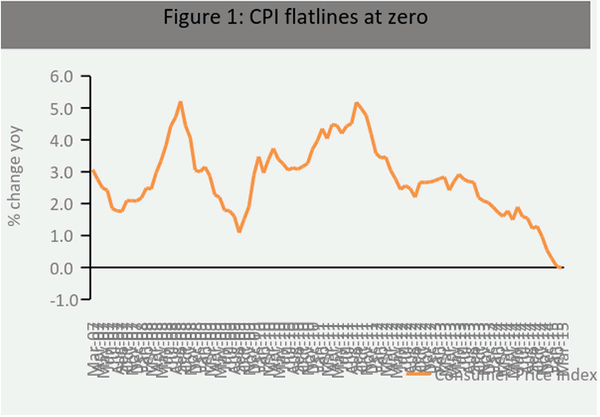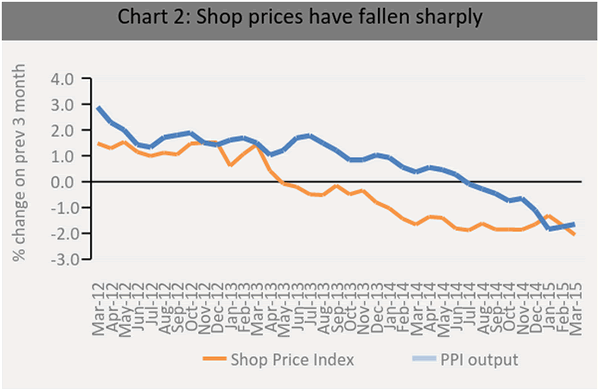Inflation flatlines – although "technically" we are in deflationary times
UK inflation held at zero in March, matching the record low of the previous month. It could yet fall into deflationary territory but, irrespective of a negative number, we expect inflation to remain at subdued levels for the remainder of the year. “Technically”, given the unrounded inflationary figure at two decimal places is -0.01% - we are in a period of deflation! We believe a brief period of deflation, or low inflation, will be beneficial to the consumer sector as nominal wage growth continues to rise, boosting households’ spending power. Supported by robust consumer confidence, a stronger labour market and rising asset prices, consumer spending will benefit in the coming months.Downward pressure on inflation continued to come from food and transport, in the main, although a sharp drop in clothing and footwear helped cancel out upward pressures elsewhere in the consumer basket.

Source: ONSThe outlook for inflation remains benign as past falls in the price of oil and soft commodity prices continuing to feed through the supply chain.

Source: ONS, BRC-NielsenChart 2 shows that shop prices have remained deflationary for 23 consecutive months with the latest data recording a 2.1% fall, year-on-year. According to the BRC-Nielsen Shop Price Index, the components pushing down inflation are Clothing and Footwear (-7.8%), Electricals (-5.8%), Furniture and Flooring (-1.4%), Food (-0.9%) and Books and Stationery (-4.6%). In fact, the only areas to show any upward price movement is from Health and Beauty (+0.6%) and Other Non-Food (+1.0%). The fall in the price of oil and softer commodities are feeding through the supply chain. Retailers are faced with lower costs being passed on from suppliers but are in turn passing these savings on to consumers as competition in the sector intensifies – particularly in the food sector. The Producer Price Index (PPI), which acts as an accurate indicator for costs faced by retailers, has fallen for nine consecutive months. The latest figure for March showed deflation of 1.7%, slowing marginally from the previous month. It would appear that the brief period of falling costs outweighing falling prices has now reversed. In essence, a brief window for retailers to rebuild margins has now been reversed. On the household side, the main components driving down inflation continue to come from transport, energy costs and food – products which are relatively price insensitive. Most people are unlikely to choose to drive a longer way to work or eat more during lunch as prices for these products fall. Therefore, household will see a tangible boost in disposable incomes as prices across non-discretionary items fall and wages continue to rise. Providing households do not decide to increase levels of saving by the same amount, consumer spending will rise. While the grocery sector is facing its own set of unique challenges, the non-food sector is likely to benefit from this boost in household spending power. Sectors which are particularly income sensitive, such as consumer electricals and home, are likely to see the largest benefits. The Bank of England will be keeping a close eye on the wage growth but the latest data suggests pay settlements are holding up well. The latest IDS settlement figures show that median pay has picked up to around 2.5%. It would be a concern if businesses saw a period of deflation as an opportunity to award lower pay increases, however, after five years’ of persistent low wage rises, we do not believe this to be the most likely outcome.
Back to Retail Economic News